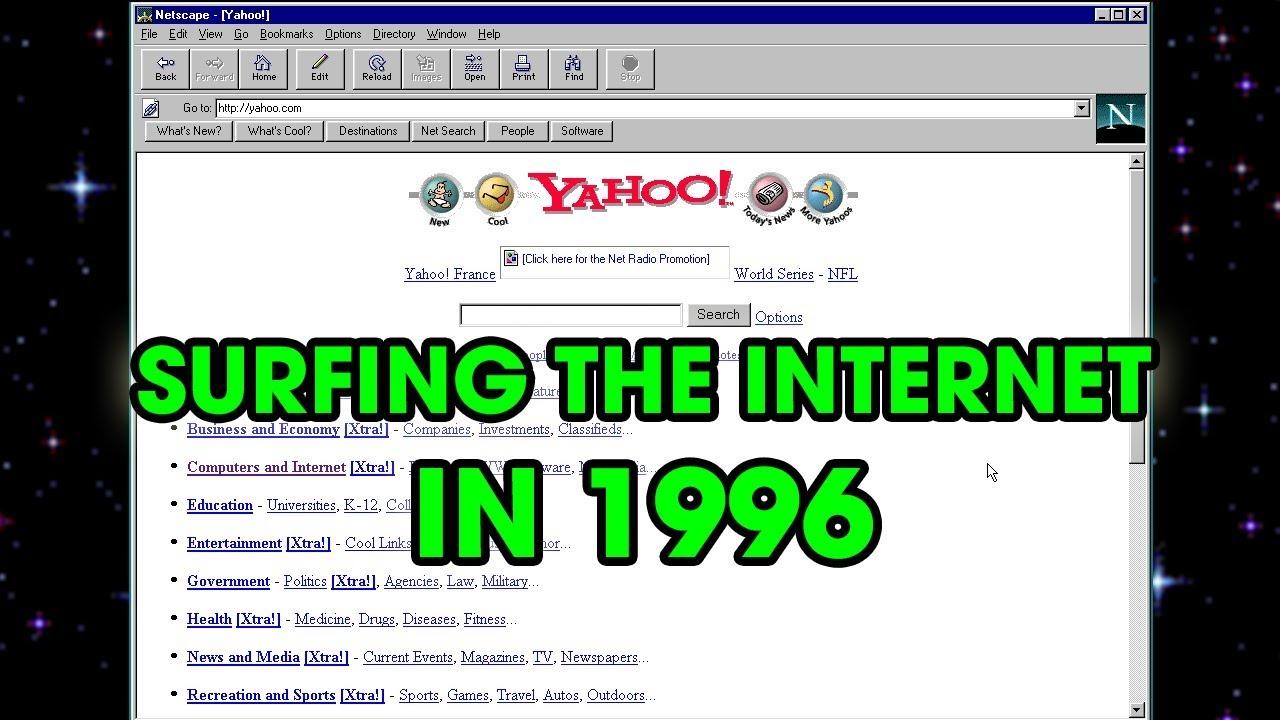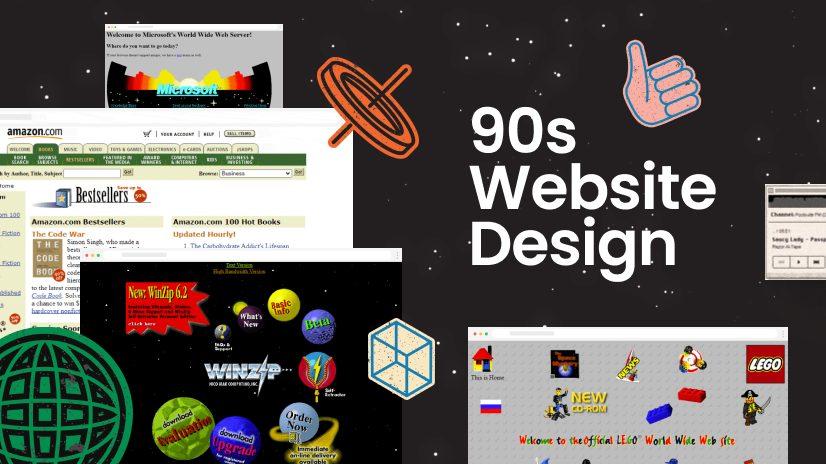Remember the ‘90s internet? It was a wild place filled with quirky designs and dial-up sounds! Join us as we stroll down memory lane with 6 classic websites that defined the era, plus 6 that are surprisingly still kicking. Don’t miss this nostalgic ride!
6 Classic ‘90s Websites (+ 6 that Are Still Up)
Ah, the ‘90s—a time of frosted tips, slap bracelets, and the birth of the internet as we know it. Remember the thrill of hearing that iconic dial-up tone as you connected to the World Wide Web? It was a digital playground where we stumbled upon quirky websites that defined an era. From GeoCities’ flashy homepages to the simplicity of early social networking, those sites were more than just pixels on a screen; they were the foundation of online culture.
But as we dive into a nostalgic trip down memory lane, let’s not just reminisce about the classics that faded away into the annals of cyberspace. Instead, we’ll explore six iconic ‘90s websites that captured our hearts and imaginations, alongside six that have stood the test of time and continue to thrive today. Whether you’re a tech-savvy millennial or a curious Gen Z’er, this journey through digital history will remind us all of the joy and chaos that shaped our early online experiences. So grab your favorite snack from that decade, and let’s log in to some serious nostalgia!
Exploring the Nostalgia of Iconic ‘90s Websites
The ‘90s were a transformative time for the internet, birthing a multitude of websites that would go on to define our online experience. Many of these sites sparked childhood memories and have become nostalgic touchstones for a generation that remembers dial-up tones and pixelated graphics. It’s almost magical to think back to the days when the web was still in its infancy, and creativity flourished in a way that felt both innocent and adventurous.
Some of the most iconic sites of the ‘90s provided us with a glimpse of what the digital world could become. They were places of discovery where users could explore everything from chat rooms to quirky animations. Here are a few that stand out:
- GeoCities: A haven for personal web pages, bursting with neon colors and animated GIFs.
- Angelfire: Built for budding webmasters, it allowed users to create their own space on the web.
- Tripod: Known for its easy-to-use tools for creating websites, it was a playground for creativity.
- eBaum’s World: A hub for bizarre videos and memes, it captured the quirky spirit of the early internet.
- Newgrounds: An indie platform that showcased flash animations and games, fostering burgeoning creativity.
- Ask Jeeves: A search engine with a twist; asking a butler for answers felt both sophisticated and fun.
While some of these sites have vanished into the ether of the internet, others have adapted to modern times, continuing to resonate with users. For instance, Newgrounds remains a vibrant community for artists and gamers alike, proving that nostalgia can thrive alongside innovation.
Interestingly, many of these websites have influenced today’s digital landscape in unexpected ways. The stylistic choices, community-building ideas, and multimedia elements that flourished in the ‘90s have become foundational blocks for today’s social media and content sharing platforms.
| Website | Status | Notable Feature |
|---|---|---|
| GeoCities | Gone | Personal web pages |
| Angelfire | Still Up | Free website hosting |
| Newgrounds | Still Up | Indie games and animations |
| eBaum’s World | Still Up | Humor and memes |
| Ask Jeeves | Rebranded | Conversational search engine |
| Tripod | Still Up | Website creation tools |
As we scroll through these digital relics, it’s easy to celebrate how far we’ve come while cherishing the simplicity and charm of those early days. They remind us that the internet is not just a tool but a vibrant tapestry woven with the stories we’ve shared and the memories we’ve created.
A Trip Down Memory Lane with Classic Web Design Trends
Ah, the ’90s—a decade that defined the internet as we know it today. The early days of web design were a canvas for creativity, albeit with a splash of chaos. Websites were a wild mix of bright colors, animated GIFs, and clashing fonts. They reflected the exuberance of the new digital frontier, capturing the spirit of a generation that was just discovering the power of the World Wide Web.
Take a moment to reminisce about those glorious days filled with:
- Marquee Text: Remember when scrolling text was the height of cool? Every site felt alive with those neon banners gliding across the screen.
- Background Music: Websites that played soft MIDI tunes or catchy jingles as you browsed became an essential part of the user experience—whether you loved it or hated it!
- Counter Widgets: Everyone wanted to show off their visitor count. Those little counters were a badge of honor, signifying a site’s popularity.
- Frames: Ah, the infamous frames that allowed websites to display multiple sections at once. They were a love-hate feature that added complexity but also versatility.
Interestingly, some of these early gems still hold a place on the internet today. They may not exactly be the epitome of modern design, but their charm is undeniable. Here’s a quick look at a few classic websites that have stood the test of time:
| Website | Launch Year | Status |
|---|---|---|
| Craigslist | 1995 | Active |
| DeviantArt | 2000 | Active |
| IMDb | 1990 | Active |
| eBay | 1995 | Active |
Even as we look back on these classics with nostalgia, it’s fascinating to see how design trends have evolved. The early web was about experimentation, often leading to the creation of some truly unique digital landscapes. While many of these trends have faded, their influence can still be felt, reminding us of the creativity and innovation that fueled the internet’s growth.
So, as we dive into the world of ’90s web design, let’s appreciate the quirks and innovations of the time. Each pixel and texture was a stepping stone towards the sleek, user-friendly sites we visit today. After all, every great journey begins with a single click!
Uncovering the Unique Features That Made These Sites Stand Out
The internet of the ’90s was a wild frontier, a digital playground where creativity knew no bounds. Each website emerged with its own flair, offering unique features that captured the imagination of users across the globe. Let’s dive into the distinctive elements that made these classic sites memorable and influential.
- Geocities: This was the birthplace of personal webpages, where users could create their own “neighborhoods.” The unique feature here was the ability to customize HTML to create anything from a fan page to a digital diary, fostering community among amateur webmasters.
- Angelfire: Like Geocities, Angelfire offered free web hosting, but its standout feature was the inclusion of a site builder that allowed users to create pages without needing to learn HTML. The simplicity empowered many to share their passions online.
- AltaVista: Before Google monopolized search, AltaVista was revolutionary with its robust search capabilities. It was one of the first to index the entire web and support complex queries, making it a must-visit for anyone looking to uncover information online.
- eBay: The auction model was a game-changer. eBay allowed users to buy and sell items in real-time, creating a dynamic marketplace. Its rating system instilled trust and encouraged community participation, allowing individuals to monetize personal goods.
- Amazon: The original online bookstore, Amazon’s unique feature was its recommendation engine. By analyzing user behavior, it personalized shopping experiences, making it easier for customers to discover new books they might love.
- MSN Messenger: The chat feature was revolutionary for instant communication. With customizable emoticons and user-friendly interfaces, it made connecting with friends a breeze, paving the way for future social media platforms.
Fast forward to today, and we find that some of these websites have not only survived but have adapted with time while retaining their core charm. Notable among them are:
| Website | Unique Feature |
|---|---|
| eBay | Live auctions and Buy It Now options |
| Amazon | Prime membership with exclusive deals |
| Geocities | Community forums and nostalgia |
| Angelfire | Modern templates for easy site creation |
| MSN Messenger | Integration with social media platforms |
| Yahoo! | Comprehensive news and entertainment hub |
These features not only defined the websites of the ’90s but also influenced the trajectory of internet culture. They sparked creativity, fostered communities, and redefined how we interacted with the digital world. As we reflect on this era, it’s fascinating to see how the seeds planted by these pioneers continue to flourish in today’s online landscape.
Why Some ‘90s Websites Still Hold Value Today
The digital landscape has evolved dramatically since the ’90s, yet some websites from that era remain surprisingly relevant. These sites are not just relics of the past; they embody a unique charm and a sense of nostalgia that resonates with millennials and Gen Z alike. Their enduring value can be attributed to a blend of factors that keep them alive in the hearts and minds of internet users.
Firstly, the simplicity of design is a major draw. In a time when websites were primarily text-based with basic graphics, users were focused on content rather than flashy elements. This minimalist approach often made navigation intuitive. Today, many users are overwhelmed by complex layouts and endless scrolling, which makes the straightforward experience of ’90s websites appealing. Users can easily find the information they need without sifting through layers of design.
Additionally, the cultural significance of these sites cannot be overlooked. Many of them served as the foundation for online communities and social interaction. For instance, platforms like GeoCities allowed users to express themselves creatively through personal web pages. This sense of belonging and community is something that’s often missing in today’s fast-paced digital world. Users fondly remember the connections made and the individuality these sites fostered, making them valuable artifacts of early internet culture.
Moreover, the nostalgia factor plays a crucial role. As more people reminisce about their formative years spent online, visiting these classic sites evokes cherished memories. Brands and websites that once defined a generation continue to spark joy and sentimentality. This emotional connection can drive traffic to these sites, keeping them relevant even decades later.
some of these classic websites have evolved to adapt to modern technology while still retaining their core identity. This balance of nostalgia and innovation allows them to maintain a loyal user base. For example, sites that have embraced responsive design and updated content while staying true to their roots have successfully bridged the gap between past and present.
the value of certain ’90s websites lies not only in their historical significance but also in their ability to evoke nostalgia and foster community. As we continue to navigate an increasingly digital world, these sites remind us of a simpler, more authentic online experience that many long for.

The Enduring Appeal of Vintage Internet Culture
As we dive into the nostalgic realm of vintage internet culture, it’s captivating to see how the online landscape has evolved yet certain elements remain deeply cherished. The early days of the web were marked by quirky designs, unfiltered creativity, and a sense of community that many of us reminisce about fondly. The charm of these classic websites isn’t just in their aesthetics; it’s the memories and experiences they evoke. There’s an undeniable warmth in the simplicity of early internet interactions, one that modern platforms often overlook in their quest for sleekness and efficiency.
For many, visiting these sites is akin to opening an old photo album. You might remember the thrill of discovering content that was not curated by algorithms but by genuine passion. Geocities, for instance, transformed ordinary users into webmasters, allowing them to express themselves in ways never before possible. Each personal homepage was a unique reflection of its creator, cluttered with animated GIFs and custom backgrounds, creating a vibrant tapestry of internet culture.
Another gem from the past is Angelfire, which served as a launching pad for countless aspiring web designers. Its enchanting blend of simplicity and creativity empowered users to showcase their hobbies, interests, and art, often resulting in wildly colorful and eclectic web pages. It’s fascinating to note that many of these sites are not just relics; they have been preserved or revived, allowing a new generation to experience the raw energy of early web culture.
Here’s a quick look at some classic sites that have stood the test of time:
| Website | Original Launch Year | Status |
|---|---|---|
| Geocities | 1994 | Archived |
| Angelfire | 1996 | Still Active |
| MySpace | 2003 | Still Active |
| Xanga | 1999 | Revived |
| Ask Jeeves | 1996 | Rebranded |
| Newgrounds | 1995 | Still Active |
The enduring charm of these websites lies in their ability to evoke a sense of nostalgia. They remind us of a time when the internet was a Wild West of creativity, a playground for dreamers and innovators. The community aspect, evident in platforms like Newgrounds and Xanga, fostered connections that transcended geographical boundaries. Users didn’t just browse; they interacted, collaborated, and shared experiences that felt genuine and authentic.
Today, as we navigate a digital world dominated by social media giants and corporate platforms, it’s refreshing to look back on the era of personal expression that vintage websites championed. They serve as a reminder that the internet is not merely a tool for consumption but a canvas for creativity, connection, and personal expression. Embracing the spirit of these early platforms can inspire us to reclaim the internet as a space for individuality and authenticity.

Rediscovering the Classics: Websites That Are Still Thriving
As we dive into the digital landscape of the ’90s, it’s fascinating to see how certain websites have stood the test of time. While many platforms have come and gone, some have adapted and evolved, maintaining their relevance in an ever-changing online world. Here’s a look at a few of those classic sites that are still thriving today.
1. Geocities – Remember the nostalgia of customizable homepages? While Geocities itself has shut down, many similar sites have emerged, allowing users to create personal web spaces packed with creativity and flair. Check out NeoCities for a modern take on that classic vibe!
2. eBay – Originally launched in 1995, eBay has transformed the way we buy and sell goods online. Its auction format was revolutionary, and it continues to thrive as a leading marketplace for both new and vintage items. You can still find treasures from yesteryear alongside the latest gadgets.
3. IMDb – The Internet Movie Database, founded in 1990, remains the go-to resource for film enthusiasts. With a wealth of information on movies, TV shows, and actors, IMDb has consistently updated its database, making it indispensable for anyone looking to dive into cinematic history.
4. Wikipedia – Launched in 2001, Wikipedia embodies the spirit of the internet as a collaborative knowledge-sharing platform. While it technically emerged a bit later in the decade, its roots are deeply embedded in the ’90s ethos of open information. Today, it boasts millions of articles in countless languages, proving that knowledge is indeed power when shared.
5. Craigslist – Since 1995, Craigslist has remained a staple for classifieds, connecting people for everything from job searches to apartment hunting. Its simplistic design is a refreshing nod to the past, and it continues to be a vital resource for local communities.
6. Amazon – What started in 1994 as an online bookstore has morphed into a global e-commerce giant. Over the years, Amazon has expanded its offerings beyond books, transforming the way we shop. Its adaptability ensures that it remains a leader in the online retail space.
| Website | Launch Year | Current Relevance |
|---|---|---|
| eBay | 1995 | Leading online marketplace |
| IMDb | 1990 | Top film and TV resource |
| Wikipedia | 2001 | Extensive knowledge database |
| Craigslist | 1995 | Popular classifieds platform |
| Amazon | 1994 | Global e-commerce leader |
The resilience of these websites speaks volumes about their ability to adapt to changing technology and user needs. They remind us that while the internet may evolve, the core principles of connectivity, community, and commerce remain as vital as ever.

How Old-School Websites Adapted to the Modern Era
The digital landscape has undergone a seismic shift since the ’90s, but some classic websites have shown remarkable resilience. Adaptation is key, and these websites have transformed themselves to fit the fast-paced, visually driven internet we navigate today. While some embraced modern aesthetics and functionalities, others retained nostalgic elements that remind us of the early days of the web. Let’s dive into how these classic sites have evolved.
User Experience Redefined
One of the most significant changes has been in user experience. In the early days, websites often boasted busy layouts filled with text and images that could overwhelm visitors. Today, many of these classics have simplified their designs to enhance usability. For instance, a minimalistic approach with ample white space and intuitive navigation now guides users seamlessly through content. This evolution reflects broader trends in web design that prioritize user engagement and accessibility.
Responsive Design
As mobile browsing surged, adapting to various screen sizes became a necessity. Older websites that once appeared static and unyielding have now integrated responsive design principles. Using CSS media queries, they ensure their content looks great on desktops, tablets, and smartphones alike. This shift not only broadens their audience but also aligns with Google’s mobile-first indexing, keeping them relevant in search results.
Content Management Systems
Gone are the days of manually coding each page. Many vintage sites have transitioned to modern Content Management Systems (CMS) like WordPress, allowing for easier content updates and improved functionality. This backend overhaul has enabled them to introduce features like blogs, multimedia galleries, and user-generated content, fostering community engagement that was once a challenge.
| Classic Site | Modern Adaptation |
|---|---|
| Geocities | Community forums and user portfolios |
| Angelfire | Drag-and-drop site builders |
| MySpace | Music streaming and artist promotion |
| Tripod | Responsive templates and site analytics |
| Homestead | Integrated e-commerce solutions |
Engaging with Social Media
Another crucial adaptation has been the integration of social media. Classic websites now promote sharing and interaction through platforms like Facebook, Twitter, and Instagram. This not only helps them reach wider audiences but also fosters a sense of community among users. By leveraging social media tools, they can engage with visitors in real time, making the web experience more dynamic.
Embracing Multimedia
the shift from text-heavy content to multimedia is unmistakable. Classic websites have begun to weave in videos, podcasts, and interactive elements that cater to diverse preferences. This multimedia approach caters to a broader audience, making content more appealing and digestible. It’s a strategy that recognizes the importance of varied learning styles and the craving for rich, engaging experiences.

Lessons from the Past: What Today’s Sites Can Learn from ‘90s Favorites
As we explore the digital landscape shaped by the glimmering pixels of the ‘90s, it’s hard not to feel a sense of nostalgia. The era was defined by a raw, unfiltered creativity that paved the way for the internet’s evolution. Today’s websites can draw invaluable insights from these pioneering platforms, blending the charm of yesteryear with modern functionality. Here are some key takeaways:
- Simplicity Reigns Supreme: The simplistic designs of ‘90s websites often focused on user experience over flashy graphics. Today, minimalism is a powerful trend that ensures users can navigate easily and find what they need without distraction.
- Authentic Connection: Many classic sites fostered a sense of community through guestbooks and forums. Modern sites can benefit from engaging with users by creating similar interactive spaces, encouraging feedback, and fostering genuine relationships.
- Personalization: Back then, websites often felt personal, almost like visiting a friend’s page. Today, integrating personalized content can make users feel valued. Tailoring recommendations and content based on user behavior can enhance engagement significantly.
- Embrace Quirkiness: The ‘90s were all about unique personalities shining through. Incorporating a bit of whimsy or a distinctive voice can help a website stand out in a crowded digital marketplace.
To visualize how these lessons can be applied today, let’s consider a few examples:
| Classic ‘90s Website | Modern Takeaway |
|---|---|
| GeoCities | Foster a community vibe with user-generated content. |
| Angelfire | Incorporate simplicity in design to enhance usability. |
| Yahoo! | Offer personalized content recommendations. |
| Ask Jeeves | Utilize friendly and approachable brand language. |
Importantly, the ‘90s taught us that innovation comes from understanding user needs. While technology has evolved, the fundamental principles of good design and user engagement remain relevant. Embracing a user-centric approach, inspired by the classic websites of the past, can create a more satisfying and memorable experience today. It’s not just about looking back; it’s about using those lessons to forge a path forward in our ever-changing digital world.

Navigating the Digital Landscape: Blending Nostalgia with Innovation
As we traverse the ever-evolving digital landscape, it’s fascinating to reflect on the websites that shaped the internet in the ’90s. These platforms not only introduced us to the World Wide Web but also sparked a sense of nostalgia that continues to resonate today. Think of the vibrant colors, the pixelated graphics, and the dial-up sounds that once filled our homes. Let’s take a moment to celebrate six classic ’90s websites that remain iconic, alongside six modern counterparts that keep the spirit alive.
Classic ’90s Websites:
- GeoCities: A pioneer in personal web hosting, GeoCities allowed users to create their own quirky online spaces, complete with animated GIFs and guestbooks.
- Angelfire: Similar to GeoCities, Angelfire was a platform where you could build your website for free, often adorned with flashy backgrounds and MIDI music.
- MySpace: Before Facebook took the crown, MySpace was the go-to social networking site for music lovers and creative souls, where profiles were personalized to the max.
- eBay: The original online marketplace, eBay revolutionized how we buy and sell, turning everyday folks into entrepreneurs.
- Ask Jeeves: This unique search engine allowed users to ask questions in natural language, making information retrieval feel more accessible and friendly.
- Hotmail: One of the first webmail services, Hotmail changed how we communicated, allowing us to send emails anywhere in the world.
Websites that Are Still Thriving:
- eBay: Still a dominant force in online sales, eBay has evolved but retains its foundational spirit of community and commerce.
- MySpace: While not as mainstream, it has pivoted to focus on music and creative content, appealing to a niche audience.
- Yahoo: Once a search engine juggernaut, Yahoo has transformed into a media company, still holding a significant user base.
- Amazon: From a humble online bookstore to an e-commerce giant, Amazon is a testament to innovation and adaptation.
- Craigslist: It may not have the sleekest interface, but Craigslist remains a beloved platform for classifieds and community connections.
- Reddit: This social news aggregation site thrives on user-generated content and has become a hub for diverse communities and discussions.
While technology has advanced and designs have evolved, the essence of these classic sites resonates in the modern web. They remind us of a time when the internet felt like a new frontier filled with possibilities. Today’s platforms, whether they emulate the nostalgic charm of the past or push the boundaries of innovation, owe a debt to the trailblazers of the ’90s.
| Classic ’90s Website | Modern Equivalent |
|---|---|
| GeoCities | Wix |
| eBay | Amazon |
| MySpace | SoundCloud |
| Ask Jeeves | |
| Hotmail | Gmail |
| Angelfire | Weebly |
Ultimately, the journey from the pixelated past to today’s sleek interfaces showcases the digital evolution. Embracing nostalgia while welcoming innovation isn’t just a balancing act; it’s a celebration of where we’ve been and where we’re heading. The past informs the future, and as we continue to explore, let’s hold onto that blend of memory and modernity that makes our digital experiences uniquely enriching.

The Future of Retro: What’s Next for Classic Websites
As we take a nostalgic stroll down memory lane, it’s fascinating to ponder what the future holds for classic websites. The web has transformed dramatically since the ‘90s, but the charm of those early sites continues to captivate. These relics aren’t just historical markers; they represent a unique blend of creativity, simplicity, and authenticity that modern web design often lacks. So, what’s next for these digital time capsules?
First and foremost, the revival of retro aesthetics is gaining traction. Designers are increasingly incorporating vintage design elements into their work, celebrating pixel art, bright color palettes, and basic HTML layouts reminiscent of the early internet. This movement is not just about nostalgia; it taps into a growing desire for authenticity in a world dominated by sleek corporate designs. Imagine seeing a resurgence of animated GIFs, marquees, and even the dreaded under construction icons! These quirky features could find new life as a playful nod to the past.
Moreover, with the rise of the retro gaming culture, we might see classic websites integrated into interactive experiences. Think of a platform where users can explore vintage sites while playing games or completing challenges based on the content and layout of these pages. This would not only enliven the sites but also educate younger generations about the internet’s evolution and the creativity that flourished during its formative years.
Another exciting aspect is the potential for community-driven projects. As internet users become more conscious of preserving digital history, we may witness collaborations aimed at archiving and revamping classic websites. These could involve developers and designers working together to modernize the user experience while keeping the original spirit intact. It would be akin to restoring an old car—keeping the classic look while upgrading its performance for today’s standards.
In terms of technology, the availability of no-code platforms could empower enthusiasts to recreate their favorite classic websites with ease. Such platforms would enable individuals to share their versions of these classics without requiring extensive coding knowledge. Imagine a community where users can showcase their renditions of early websites and even create mashups that blend elements from various sites into a new, nostalgic experience!
| Classic Website | Year Launched | Status |
|---|---|---|
| GeoCities | 1994 | Defunct |
| Angelfire | 1996 | Still Up |
| MySpace | 2003 | Revamped |
| Friendster | 2002 | Defunct |
| Neopets | 1999 | Still Up |
| 2005 | Still Up |
Ultimately, the future of classic websites is bright and brimming with possibilities. As we cherish the past, we can also embrace innovative ideas that breathe new life into these digital treasures. By combining nostalgia with modern technology and design principles, the web can continue to evolve while honoring its rich history.
Frequently Asked Questions (FAQ)
Q: What are some classic ‘90s websites that we still remember?
A: Ah, the ‘90s! A time when the internet was a wild frontier, and websites had a certain charm that’s hard to forget. Some classics include GeoCities, which allowed users to create their own personal web pages, and AOL, the gateway to the internet for many of us. And who could forget the iconic Yahoo! homepage, with its colorful directory of the web? Then there’s the nostalgic presence of eBay, which revolutionized online shopping, and Angelfire, another platform for personal sites. let’s give it up for the original version of The Internet Archive, which is like a time capsule of the early web!
Q: Are any of these websites still active today?
A: Yes, surprisingly! While some have transformed significantly, others have managed to maintain their original essence. eBay is still going strong, evolving into one of the largest e-commerce platforms in the world. Yahoo! has also adapted, though it looks very different from its ‘90s glory days. And The Internet Archive is still up and running, serving as a vital resource for preserving digital history. Isn’t it amazing how some of these platforms have stood the test of time?
Q: What makes these ‘90s websites so memorable?
A: It’s all about nostalgia! These websites were at the forefront of a digital revolution. They introduced many of us to the internet and paved the way for how we interact online today. The bright colors, quirky animations, and often chaotic layouts hold a special place in our hearts. They remind us of a time when the web felt new and exciting, and exploring it was a thrilling adventure.
Q: Are there any classic websites that have disappeared?
A: Absolutely! Many beloved sites from the ‘90s have sadly vanished into cyberspace. For example, GeoCities closed down in 2009, taking with it countless personal pages and memories. Similarly, sites like Ask Jeeves and MSN Messenger have become relics of the past. It’s bittersweet to think about what we’ve lost, but it also highlights how lucky we are to have the remaining platforms that continue to thrive.
Q: How can I revisit these classic websites today?
A: Re-exploring these classic sites can be a fun trip down memory lane! You can visit archived versions of many of these websites using the Wayback Machine at The Internet Archive. Just enter the URL, and you can see how it looked in its heyday! It’s like having a time machine at your fingertips. Plus, you might find some hidden gems you forgot about!
Q: Why should we care about these classic websites today?
A: Revisiting these classic websites is more than just nostalgia; it’s about understanding the evolution of the internet and our digital culture. They remind us of how far we’ve come and offer valuable lessons in web design, community building, and digital communication. Plus, it’s a great conversation starter! Sharing those memories can spark connections with others who experienced the same web adventures.
Q: What are some tips for anyone interested in exploring the early internet?
A: Start by digging into the archives! Check out The Internet Archive, explore old web directories, and browse forums or groups dedicated to ‘90s internet culture. Also, consider joining online communities that celebrate retro tech; you’ll find fellow enthusiasts who share your passion. Lastly, don’t forget to share your findings! Whether it’s through social media or blogs, talking about your discoveries is a fun way to keep the spirit of the early internet alive.
Insights and Conclusions
As we wrap up our trip down memory lane, it’s clear that the ’90s were a transformative time for the internet, shaping how we connect, learn, and even shop today. From the nostalgic charm of GeoCities to the quirky community of Angelfire, these classic websites remind us of a simpler online era where creativity thrived and personalization was key.
But what’s even more exciting is how some of these sites have adapted and survived the test of time. They’ve evolved from their humble beginnings, embracing new technologies while retaining a touch of their original spirit. Whether you’re reminiscing about the good old days or curious about how these platforms have transformed, there’s something captivating about the resilience of the internet.
So, the next time you find yourself scrolling through your favorite social media feed, take a moment to appreciate the roots of the web we know today. Dive back into these classic sites, explore their modern iterations, and discover how far we’ve come. Who knows? You might just find a little spark of nostalgia that inspires your next online adventure. Happy browsing!





